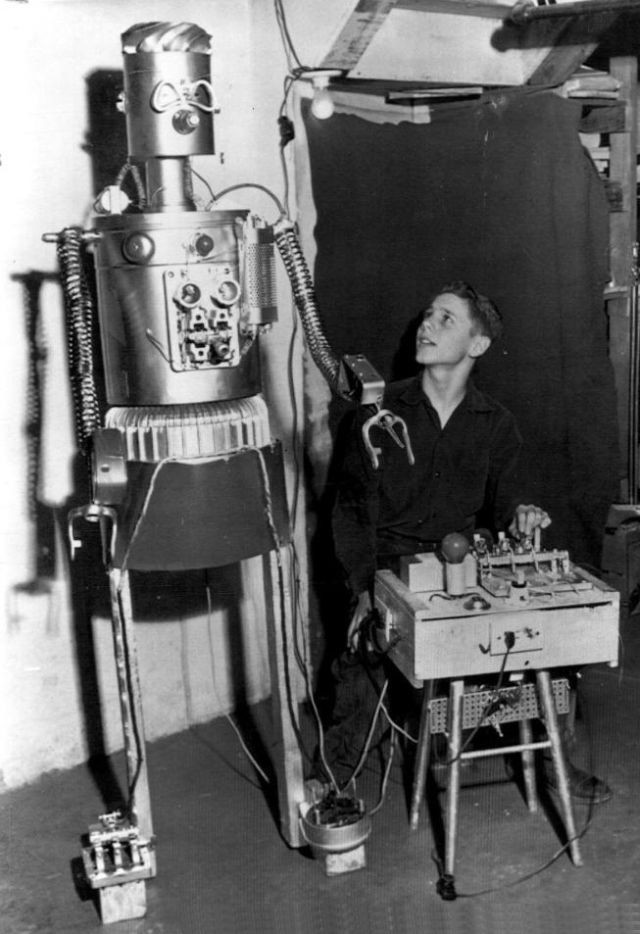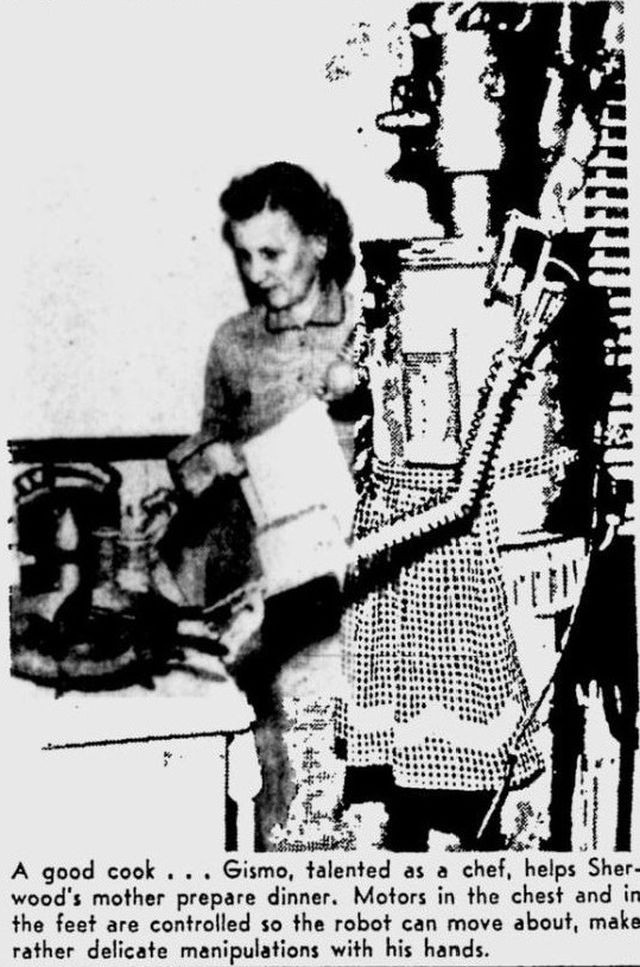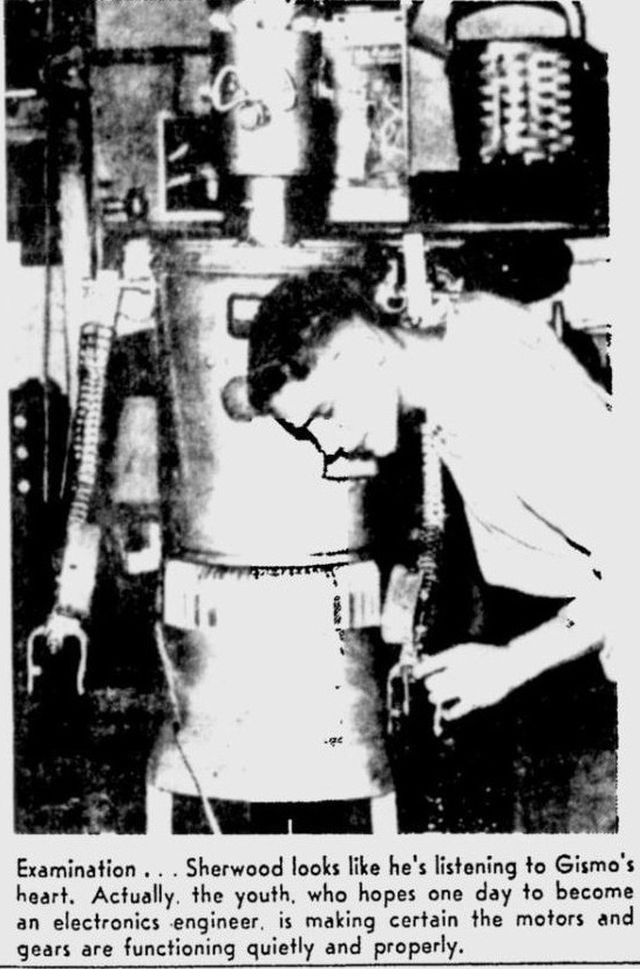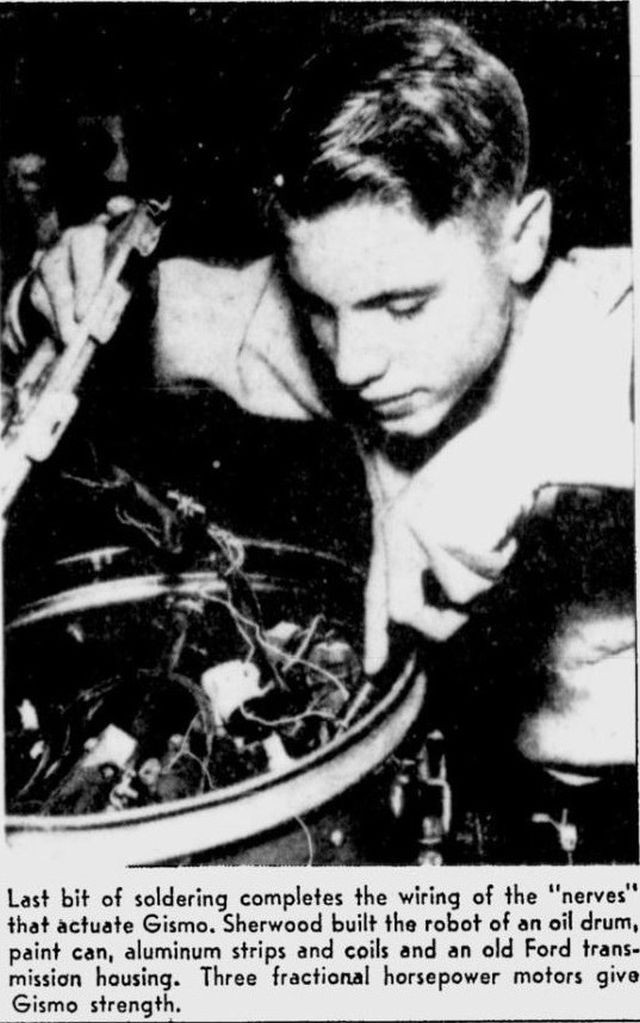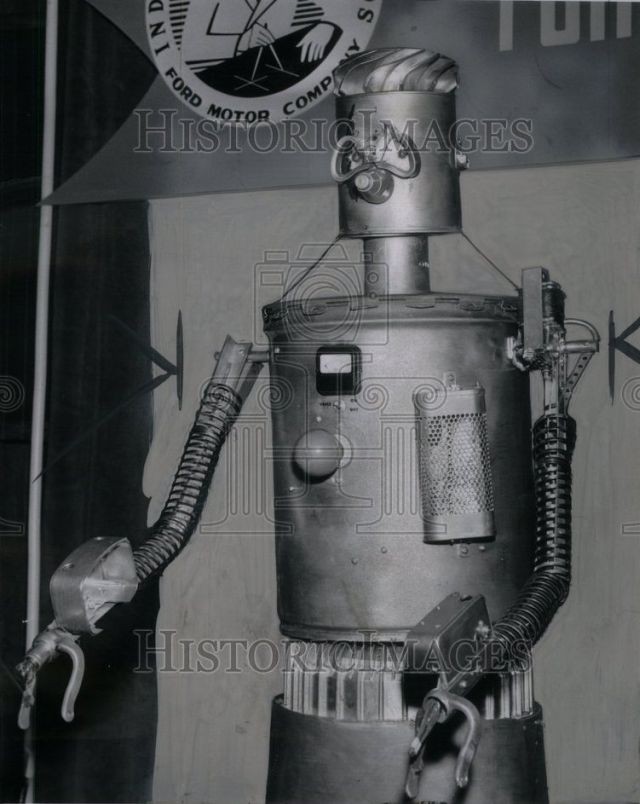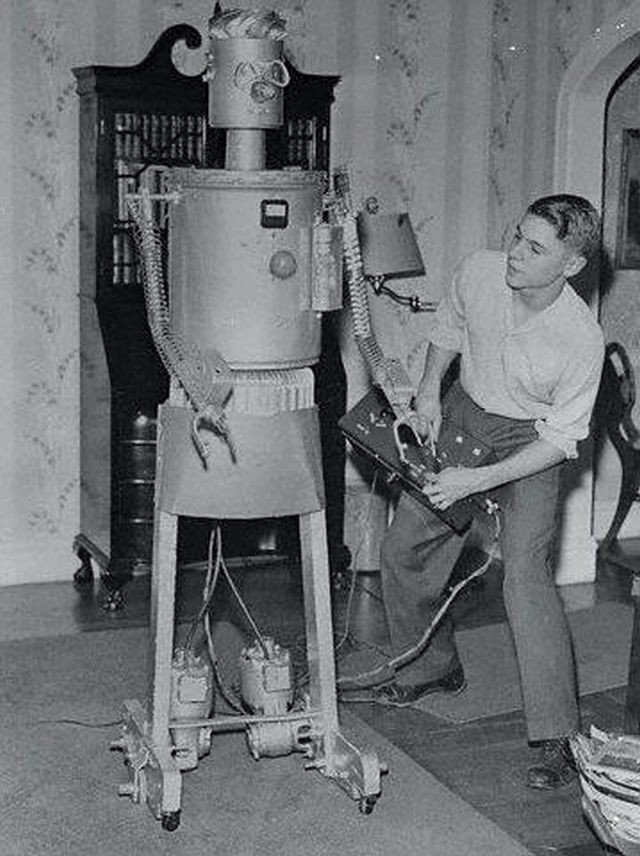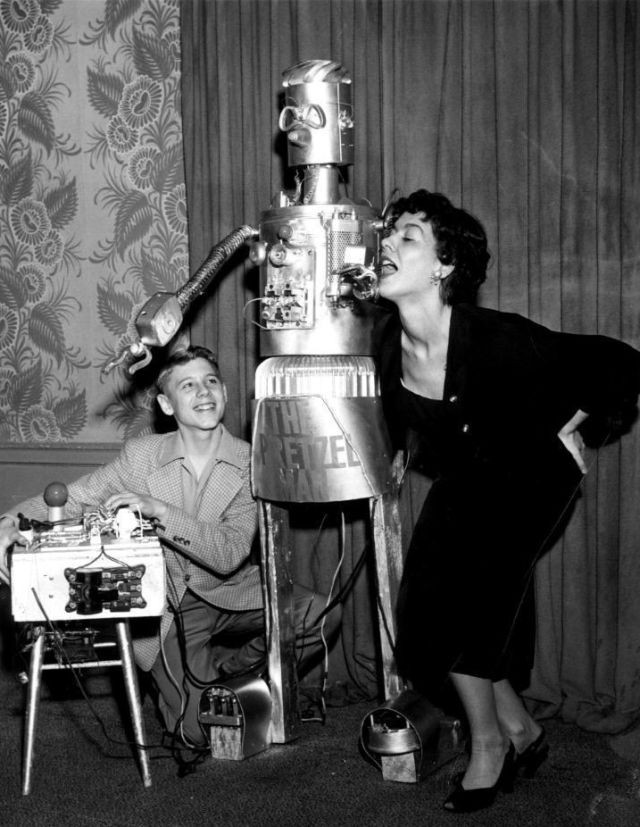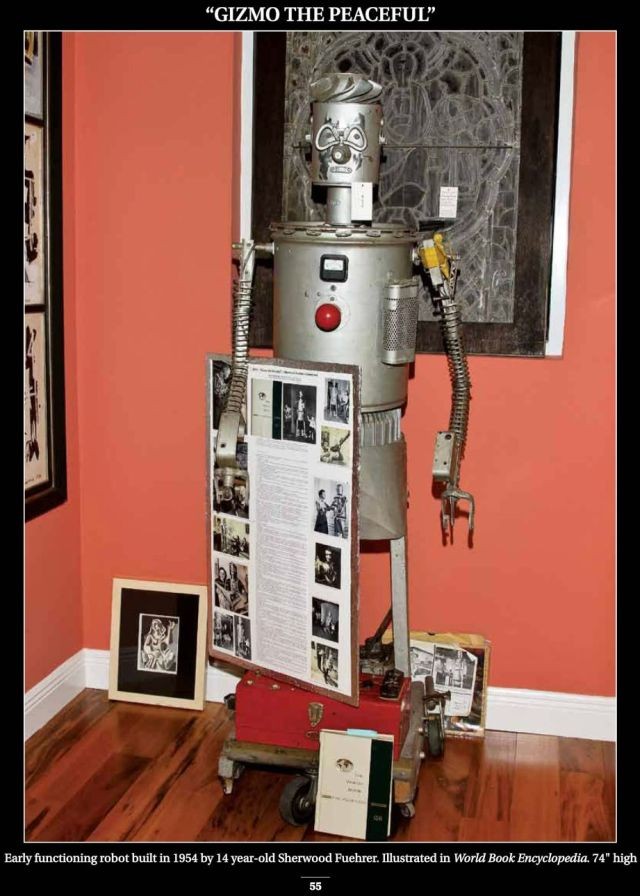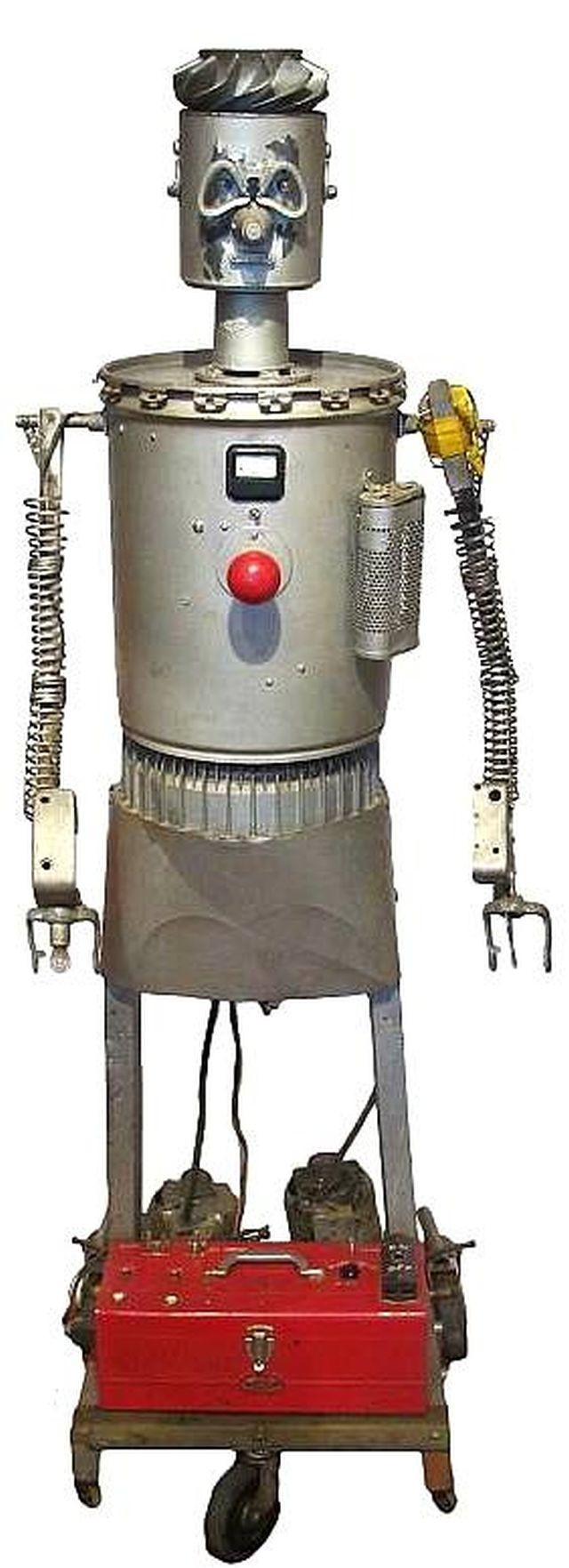March 23, 1954
ROBOT DEMONSTRATED: In Cranston, R.I., yesterday—Sherwood Fuehrer, 13, operated the controls of a robot he built from cans, gears, motors, die castings and other articles too numerous to mention. The robot —5 feet 11 inches tall and weighing 92 pounds—can hold a plate of cookies and pass them to guests.
[Below] The 1955 version – notice the different powered feet.
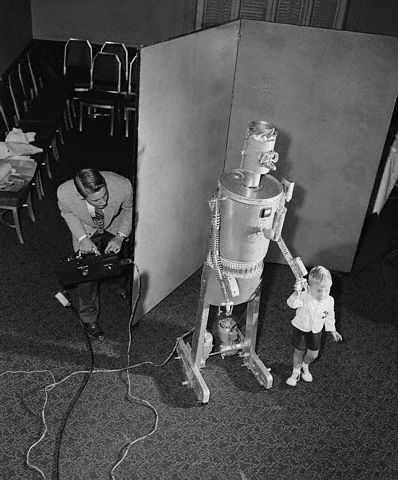
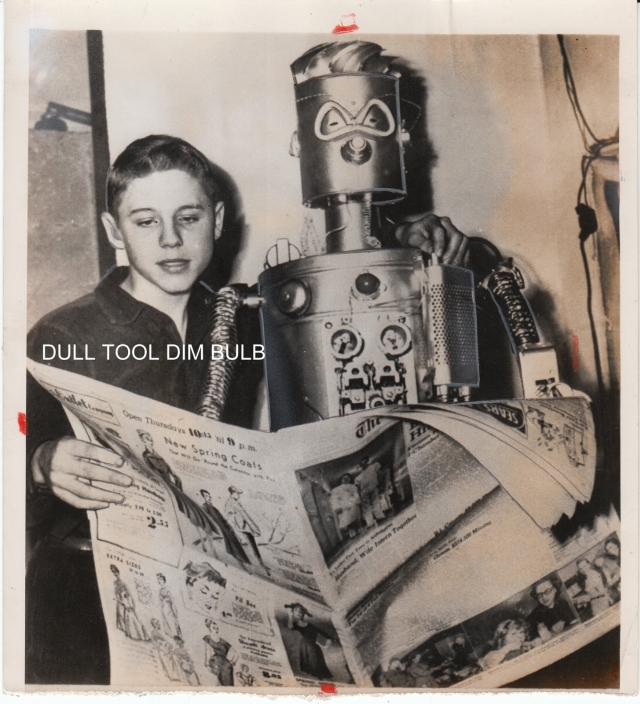
[above image from Jim Linderman's site.]
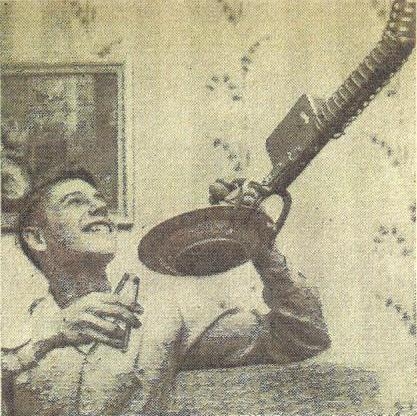
Gismo serves his master faithfully. Note how claw arrangement serve as fingers.

Mr. and Mrs. Fuehrer enjoy being waited upon by Woody and Gismo.
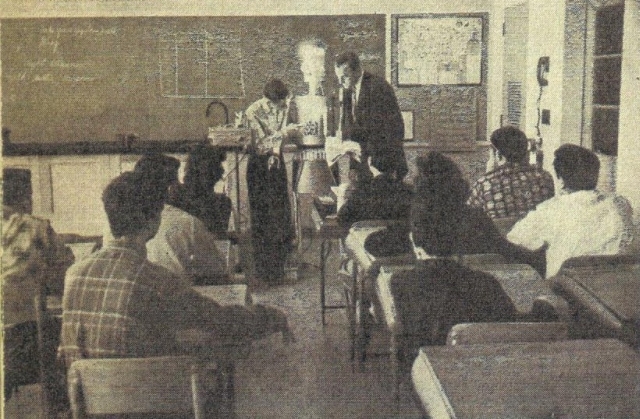
Woody demonstrates Gismo the first to general science class as teacher Richard Kells looks on. First Gismo weighed 98 pounds.
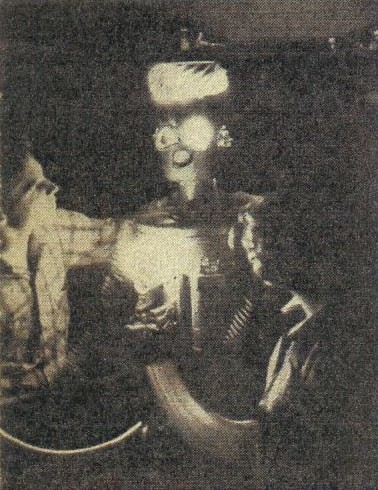
A glowing Gismo gets many evening visitors.
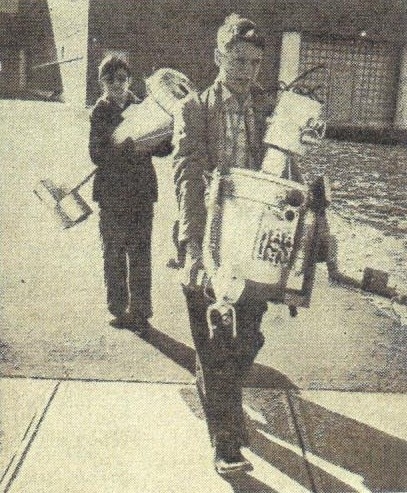
The latest Gismo tips the scale at 150 pounds and must be dismantled to travel.

[above image from Jim Linderman's site.]
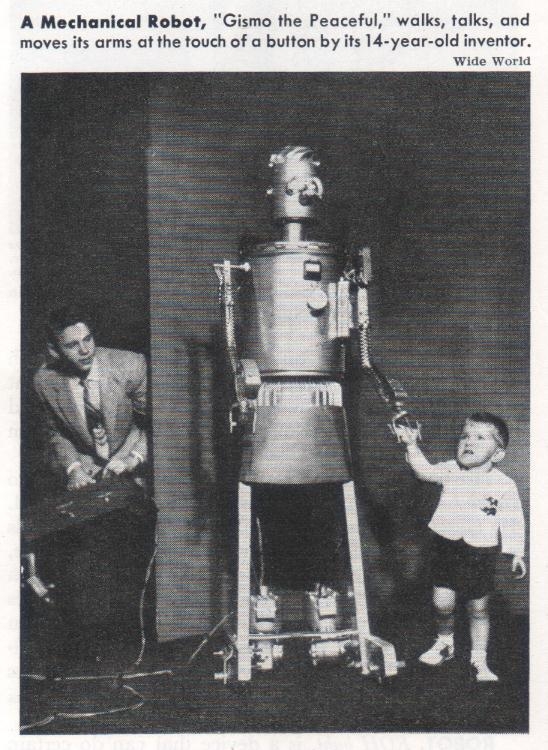
The above photo is a scan from the American "World Book Encyclopedia". For a lot of people around the globe with their own set of World Book Encyclopedias, or in public libraries, this is what a robot was and looked like for a long time.
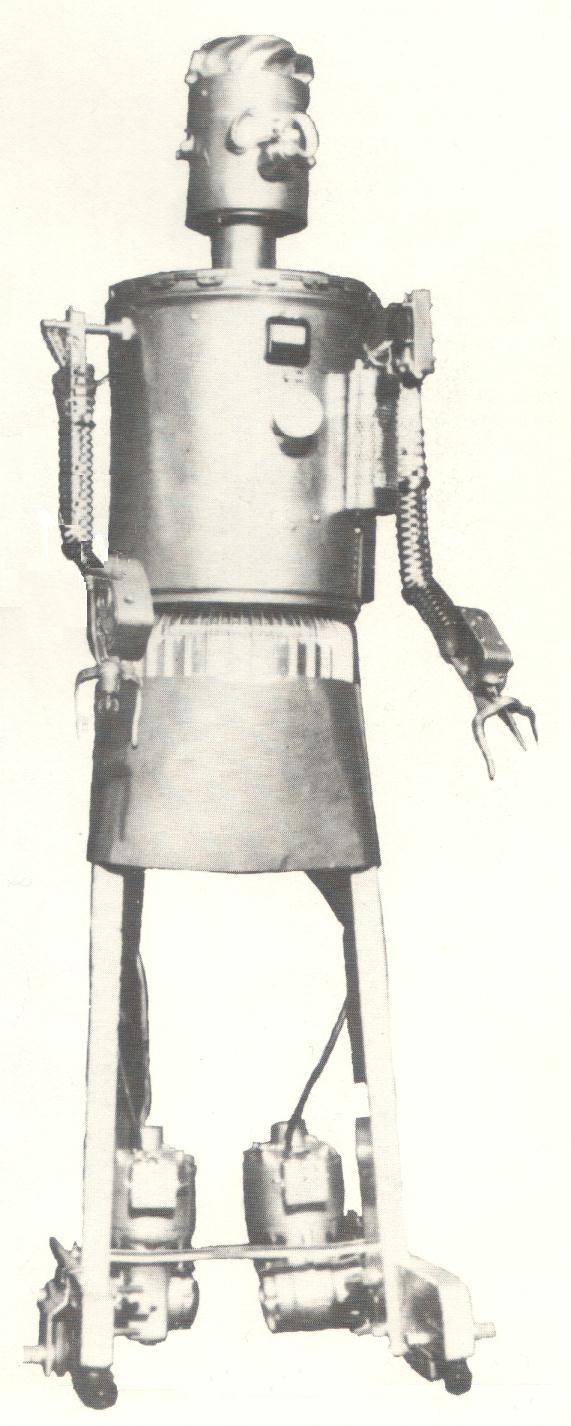
Above: The 1955 version of "Gismo".
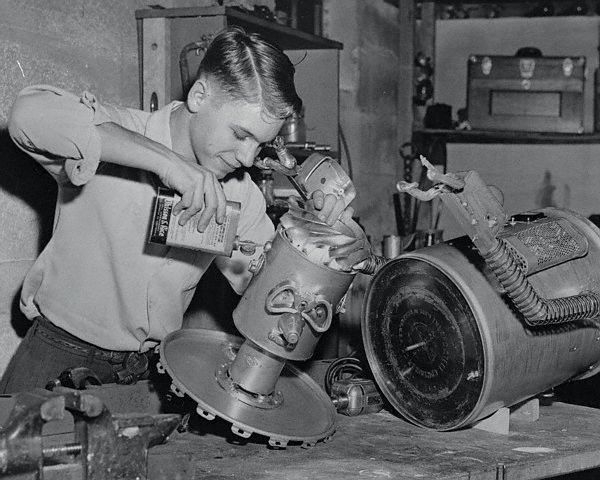
Boy's Life – June 1956
BEFORE WE GOT TOGETHER, THINGS WERE PRETTY TAME AT HOME. AN OCCASIONAL BLAST FROM A REMOTE-CONTROLLED HORN OR FIRECRACKER
GISMO AND I
BY SHERWOOD FUEHRER
I WAS THIRTEEN. I had just completed my latest project, a clock radio made with junk parts that I had accumulated, and was looking for new ideas.
My older brother Dick was reading an issue of POPULAR MECHANICS. I walked over and asked him for a suggestion. He didn't completely approve of my experimenting—mainly because it was in the line of waking him up at 3 a.m. by remote-controlled auto horns, timed firecrackers, and such.
Looking up with the bored expression, common to older brothers, he said," Oh, Woody, why don't you build a robot—like the one in this article?" pointing to a page in the magazine.
It was a crazy idea, but it had possibilities.
1 went down to the cellar of our Cranston, Rhode Island, home and looked for parts. There were a couple of two-by-fours that could be used for legs, and an empty oil can would do for a head. I could get some metals bars for arms, and my dad had a motor I could use. It began to take form in my mind.
My dad, who is a die-casting engineer, had a box of sample die castings with interesting shapes. I could use those to fill in where needed.
Then I had plenty of old wire and switches lying around. My hobby is ham radio and electronics, so I'd been collecting odd parts for some time.
I needed a body, but that could wait. I started to construct the legs.
Soon my family got interested and started looking around for parts. My dad came home one night with a five-pound can of pretzels. "Once this can is empty," he remarked, "you may have it."
So I embarked with my family and friends on a pretzel eating spree, and we disposed of them in a hurry.
With the empty can as a start, I went to work. First came the arms, made from erector set bar. Then I installed an arm raising assembly. The legs finished out the bottom half.
The head came next. I inserted flashlight bulbs in the oil can for eyes, and a mortar fuse served for the nose.
I looked over the box of sample castings and picked out a sump for the neck, a transmission housing for the hips, and a stator for the hair. It began to look like a robot. My enthusiasm mounted.
I wired him with so many lights and switches and blew out so many fuses that my mother called a halt. By this time, the arms moved, a claw opened to grasp objects, the eyes flashed, and the head buzzed. A pilot light and a flashing heartbeat adorned the body.
He began to take on a unique personality, and I decided he needed a name. I remembered a dog named "Gismo," which had belonged to a science teacher of mine, and figured the name fit my robot even better than the dog. So that was that.
Gismo was now ready to meet the public, but at that time I had no idea how much of the public he was going to meet.
I entered him in the Rhode Island State Science Fair, where he won a first grant. He made quite a hit. I rigged up an "Out To Lunch" sign that I pushed in his hand when I wanted a rest from operating him.
The Providence Journal featured a story. Then the Associated Press and the United Press ran a picture. Soon Gismo was plastered all over the United States. Before the week was over, we had made our debut on two TV shows.
I became deluged with mail. Many sent clippings. One came from the island of Guam. I received two offers to buy him. Letters came from all over the United States—boys wanting plans and girls just wanting to be friendly.
Gismo had become a famous character.
Soon his picture caught the attention of the Pretzel Institute. They offered me an expense-paid trip to New York City if Gismo would show an interest in pretzels. This came natural to Gismo since his body was once full of pretzels.
My father was away on business, and my mother (To page 54)
BOYS' LIFE for JUNE, 1956
Gismo and I
(Continued from page 18)
was skeptical about traveling with a mechanical man. I convinced her that a robot could be an ideal traveling companion, so we started packing.
When we arrived at the Hotel Roosevelt in New York, we were greeted by the doorman who quickly decided we should transport Gismo on a flat car and ride the service elevator to our room on the eighteenth floor. Word soon got around the hotel that there was a robot in room 1820, and curious visitors started crowding the hall.
A Real TV Star
At five o'clock the next morning we got up to be at the television studio for Dave Garroway's show "Today." It was rough going. I got several kicks in the shins before I was through the crowd and had the robot set up in front of the studio window.
Here Gismo had his first experience with unions. Because he works with electricity, the electrical union had to clear him to operate. This they could not do in time, so he just stood in front of the window holding pretzels and frowning at J. Fred Muggs, the show's personable chimpanzee.
Our second appearance was on a children's show. The TV studio was on the top floor of the Empire State Building. We had to change elevators three times, which was quite a job, considering, the robot weighed almost a hundred pounds. At this time, Gismo didn't "walk" yet, as he does now. I decided then that "walking" was going to be a necessity for the public personality he was becoming.
The show was quite a success. Gismo blinked and served pretzels, making a real hit with the guests.
The following day I packed the robot in the car and, with a weary sigh, we started for home. My mother commented she was getting tired of being chauffeur to a mechanical man.
Back home in the cellar, Gismo spent a quiet, uneventful summer, occasionally demonstrating his talents for photographers who took pictures for magazines.
Laddie, our collie, an impressive personality himself and once the center of attention, barked ill temperedly at his new cellarmate but finally ignored him completely.
Gismo helped raise money for our church fellowship one Saturday by standing on the curb in front of a gas station advertising our car wash. He drew so many customers that it caused a traffic jam. By three o'clock I had to take him home. We couldn't handle any more cars.
My mother suggested putting him to work in the cellar, cleaning up my work bench, but Gismo's talents don't include work.
When vacation was over, I received a letter telling about the Ford Industrial Arts Award competition. So I decided to make a new Gismo which might have a chance in the contest.
The first robot had a lot of faults that had to be cleared up if he was going to meet competition. The control box was too big and bulky. He couldn't walk or talk, and he had the muscle tone of two noodles.
My first try at making Gismo walk ended in sad failure. I put rollers on his feet and was pushing him along when he suddenly tripped over a crack in the floor.
He sure needed first aid! One arm and two wrists were broken. and his pretzel-can body was mashed beyond repair.
I started to rebuild. This time I used a heavier, stronger oil drum for the body and aluminum bars for the arms. He could now lift up to ten pounds.
The Walking Robot
But I still had the problem of getting Gismo to walk. I constructed two new feet and experimented for a few weeks with arrangements of motors and belts. Finally, he rolled along like a Sherman tank, powered by a one-twelfth horsepower motor. Now nothing in the cellar was safe from his clutching hands.
I didn't have much trouble making Gismo talk. I used a three-inch radio speaker in his head and the amplifier from the same radio in his body. I connected a wire recorder to the amplifier, and Gismo could now say anything that I recorded.
For controls, I made a new panel out of a small tool box. Through a single connector,
wired twelve operations, from low voltage power to speaker cord to 110-volt current for motors. Each one had a ground wire, so the massive cord included twenty-four different wires.
I decided he was finally intelligent enough to face the Ford competition. In June last year, I started out with my parents to drive to Dearborn, Michigan, where the exhibit was to be set up. I had built the robot in three parts so I could fit him compactly in the trunk.
Crossing the United States border into Canada, we had to declare the contents of the car. When we opened up the trunk, the startled customs officer asked. "What's that?" Before he let us cross the border, I had a lot of explaining to do. He said it was the first time he had known of a mechanical man crossing into Canada.
It didn't take long to set up the robot after we arrived in Dearborn. When we drove back home, mother remarked, "I feel as if I've lost one of the family."
For a month it was quiet and peaceful.
To the Waldorf-Astoria
Then in August I received a telegram from the Ford public relations office in New York saying that I had won a sixty-dollar third prize and a fifty-dollar ingenuity award. I was invited along with my parents to the Ford press conference held at the Waldorf-Astoria in New York City, where the winning entries were to be displayed. Gismo would then tour the country with the rest of the exhibits.
At the Waldorf, I saw Gismo for the first time in two months. He was crated in a wooden box that strongly resembled a coffin. He hadn't changed, just a few scratches and a loose bolt or two. I quickly set him up, then spent some time looking over the other entries. They were really great!
I had a full schedule for the next two days. It was a lot of fun. Gismo opened the press conference luncheon with a prepared speech via recording. Most of the morning I was operating Gismo for reporters.
The next morning I got up at four o'clock to be ready for another appearance on the "Today" television show. With the electrical union cooperating, Faye Emerson and Jack Lescoulie got along fine with Gismo. But he and J. Fred Muggs almost came to blows at one point.
After the show, I was invited to fly to Chicago for the exhibit there. You don't often get a chance to travel by plane, so I was pleased with the idea. Arrangements were made for my mother and me to leave with Gismo from LaGuardia Field—Gismo going as extra baggage.
He almost got left behind. Our plane did not have doors wide enough for Gismo. A conference was called, and it was decided that he would follow us on the next flight—a plane with larger doors.
When he was taken off the plane in Chicago, he was greeted with a welcome that a movie star would have envied. An airline hostess met him with a kiss, and the event was covered by press and movie photographers. Inside the airport terminal he was asked to make a speech. Ford representatives ran in with a long extension cord for power, and he "spoke" greetings to Chicago. Gismo had become a celebrity—but was unmoved by it all.
At the Chicago press conference, Gismo got playful. Two small boys were fascinated by him and asked me to show them how he worked. With a book in his hand, Gismo walked over to one of the boys and dropped it in his lap. Then he walked away and circled back — lights flashing, buzzer sounding, and hands outstretched for the book. The other boy turned to his friend and screamed, "Give it back. Give it back," and frantically pushed the book into Gismo's hand. Then they both quickly took off in the other direction.
After confounding people in Kansas City, Los Angeles, and San Francisco, Gismo returned to Dearborn where he was exhibited at the Michigan State Fair and the Ford Rotunda. Then he came home, needing a good overhaul job.
One of the Family
Gismo has now become a real part of our family. Last Christmas, he was in the family group pictured on our greeting cards, and he stood firmly beside the Christmas tree throughout the holiday season. Brother Dick—who has been flabbergasted at what his original robot-building suggestion brought on—recorded a special Christmas greeting for our mechanical friend, making Gismo give out with enough "ho. ho, ho" to sound remarkably like Santa Claus. Wearing a reconditioned suit of red long-john underwear, fitted by my mother, he even looked like Santa.
Things now are back to normal at our house—except for a reporter or photographer dropping in every few months. "Say, what's this we hear about a robot you've built?" It's amazing how long it takes for news to spread.
With my electronics enthusiasm, I've just finished assembling a ham radio transmitter bought with some of my prize money. I'm also studying through electronics books and do-it-yourself projects, which have been our favorite form of gift-giving for Christmas and birthday.
If you hadn't guessed, I've got my career ideas set on being an electronics engineer. My dad has encouraged my experimenting. My mother accepts it with some misgivings.
Gismo has become quite a V.I.P. around our neighborhood. I am continually getting calls and suggestions for his future. One plan is to get him married. What an alarming thought! A lot of little Gismos rolling around the house. THE END
Boys' Life – Jun 1956 – Page 18 -Vol. 46, No. 6 – Magazine.
Boys' Life – Nov 1956 – Page 74 -Vol. 46, No. 11 – Magazine
Note: The Nov 1956 construction article is by Glenn Wagner, and is his simplified version of Fuehrer's Gismo.
Above caption is misplaced. It should read: Final assembly . . . Sherwood gets a helping hand from his father. Clarence Fuehrer, who holds the upper part of the robot as the youngster fits the parts together before Gismo gets his first test run.
The Milwaukee Sentinel – Feb 12. 1956
'Gismo,' Tintype Of Modern Man
'Gismo, the peaceful' … Sherwood H. Fuehrer, 15-year-old Cranston, R. I., high school student, works the control panel to give a final test to the robot he's built — an automaton that walks, talks and is generally helpful.
By WILBUR HOUGH Hearst Newspapers Special Writer Special to the Sentinel
CRANSTON. R. I. A 15-year-old high school student who hopes one day to be an electronics engineer now has a handy robot to help him on his way.
'Gismo the Peaceful,' Is the name of the automaton Sherwood H. Fuehrer has built, at a total cost of $15.
Gismo, who's made of scrap oil drums, paint cans, aluminum and two by four lumber, is quite a fellow. He can talk, walk and perform some rather delicate manipulations with his hands.
In fact, the robot Is capable enough to do some of Sherwood's chores such as helping wash the dishes and answer the front door.
WINS FORD AWARD
All this has won Sherwood the Ingenuity award in the Industrial Arts Competition sponsored by the Ford Motor Company.
Educators, who have been stressing the need for developing engineering and scientific talent among the nation's youth, are impressed by Sherwood's achievement.
Such projects. they say, enable students to get practical experience in manipulating scientific material and putting it to actual use.
This same thought Is expressed by Henry Ford II, who says "Industrial arts and trade courses in our junior and senior high schools are doing much among our young people to kindle a greater appreciation of hand skills and a spirit of pride In performence."
ALMOST HUMAN
Sherwood, in building his robot put in a few gadgets that make Gismo look almost human. There's a little red light that flickers in Gismo's chest. It looks like a heartbeat But its…
(Please Turn to Page 5, CoI. 3) [see below]
Mechanical Man Wired for Sound, Action
Tiny Motors Give Robot Motivation
(Continued from Page 1 above)
real function is to show that everything is working smoothly.
"Sometimes I'm worried that Gismo will get so enthusiastic in doing his work that he'll blow a fuse." Sherwood says.
Gismo Is wired, and controlled from a panel with the necessary switches. There is a speaker in his chest, through which he "talks" as Sherwood sends out the proper messages, either from a microphone or a tape recorder..
Fractional horsepower motors, Iwo mounted on Gismo's fret and the other inside the oil-drum chest, enable the robot to move about and perform manipulations with his hands.
THIRD ATTEMPT
The robot Is the third that Sherwood attempted. Gismo's construction took 12 months, as the youth patiently fashioned and fitted the scrap pieces together until the automaton finally could function properly.
Intricate wiring inside the robot's body carries the electrical currents that tell Gismo what to do at any time. He doesn't have a "magic brain" that permits him to get about on his own.
But the performance is quite startling as Gismo, a six-foot mechanical man, rolls along. waving his arms and striking up a conversation.
Sherwood explained that he named the robot "Gismo. the Peaceful" because he's aiming to devote his skills and know-how toward increasing the country's production with "gadgets" that will make life easier and more fruitful.
A little oil helps Gismo's "muscles" function more smoothly. Sherwood won a prize for ingenuity in the Industrial Arts Competition
sponsored by the Ford Motor Company for his construction of the robot. He built Gismo at a total cost of $15.
Last bit of soldering completes the wiring of the "nerves" that actuate Gismo. Sherwood built the robot of an oil drum, paint can, aluminum strips and coils and an old Ford transmission housing. Three fractional horsepower motors give Gismo strength.
Examination . . . Sherwood looks like he's listening to Gismo's heart. Actually the youth, who hopes one day to become an electronics engineer, is making certain the motors and gears are functioning quietly and properly.
A good cook . . . Gismo, talented as a chef, helps Sherwood's mother prepare dinner. Motors in the chest and in the feet are controlled so the robot can move about, make rather delicate manipulations with his hands.
After lugging the 98-pound robot to the Today Show and back, Woody decided Gismo needed to be self-propelled. After damaging the original attempting to motorize it, he rebuilt Gismo with a more substantial old drum body, powered by a 1/12 horsepower motor, and talking through an old radio speaker. This improved Gismo won 3rd prize and an ingenuity award in the Ford Industrial Arts Awards.
The Fuehrer family.
April 26, 1954
'PRETZEL MAN': In New York—Sherwood Fuerher, 13, manipulated the controls of a 95-pound, 6-foot-tall mechanical robot while Marge Kennedy was about to sample a pretzel out of the robot's hand. Sherwood, an eighth-grade pupil from Cranston, R. I., built the robot from pretzel cans, oil cops, spring coils and wood. He took it to New York recently for a series of radio and TV appearances.
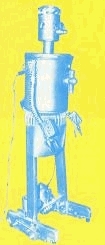
Where is Gismo now?
At the Ashley John Gallery in West Palm Beach, Florida, they actually have the original Gizmo as built by Sherwood Fuehrer. It’s in good shape though the gallery have never tried to get it to operate. Gismo has been for sale for quite awhile, since at least 2012. With a price tag of $49,500, our magnificent mechanical friend has been recognized as a historic work of art.
Sadly, Sherwood "Woody" Fuehrer died quite young, in 1964, he would have been around 24.
